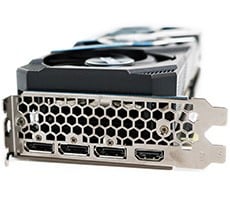Intel X48 Motherboard Round-up: ASUS, ECS, & Intel
As one of Intel's Extreme Series of Desktop Boards, the DX48BT2 natively supports 1600MHz front side bus and memory speeds. Informally known as Bonetrail2, the DX48BT2 is yet again another motherboard steeped in black, made even more menacing by the Bonetrail skulls found drawn here and there. Blue and white components provide a direct contrast to the darker board, as shown.
Package contents included a relatively odd assortment of a clear blue rounded IDE cable, a clear blue (yet not the same color) SATA cable, non-marked I/O shield, door knob hanger, board layout decal, fan bracket, drivers and applications CD, quick reference guide, a Dolby HD Theater badge for our case and a cute Skull Logo for the Southbridge heatsink. No formal written guide is included, however. An optional 40mm active cooler can be also be installed using the included bracket. Bonus software on the disc were Intel's own Desktop Control Center, Diskeeper 9 Home Edition, DivX, Dolby Control Center, and a 90-day trial version of Norton 360. Trying to woo over the gaming crowd, our set should have included a copy of Ghost Recon Advanced Warfighter 2, but, alas, it was missing in action.
|
| CPU Support for both 45nm & 65nm Intel® Core™2 Quad, Intel® Core™2 Extreme, and Intel® Core™2 Duo processors in an LGA775 socket with a 1600, 1333 or 1066 MHz system bus Support for an Intel® Pentium® dual-core processor in an LGA775 socket with an 800 MHz system bus Chipset Intel® X48 Express Chipset Front Side Bus 1600/1333/1066/800 MHz Memory Four 240-pin DDR3 SDRAM Dual Inline Memory Module (DIMM) sockets Support for DDR3 1600 MHz, DDR3 1333 MHz, DDR3 1066 MHz, or DDR3 800 MHz DIMMs Support for up to 8 GB of system memory Storage ATI CrossFire multi-GPU platform support |
On-Board Peripherals
2 x USB connectors support additional 4 USB 2.0 ports 1 x IDE connector 6 x SATA connectors 1 x IEEE 1394a connector 1 x CPU Fan connector 1 x Chassis Fan connector 1 x Power Fan connector 2 x Optional Fan connector 1 x S/PDIF Out connector 1 x 8-pin ATX 12V Power connector 1 x 24-pin ATX Power connector 1 x I/O controller for Consumer IR Back Panel I/O Ports 2 x eSATA ports 1 x IEEE 1394a 1 x LAN(RJ45) port 8 x USB 2.0/1.1 1 x Optical S/PDIF Output 5 x Audio Jacks BIOS System BIOS Flash with Intel® Platform Innovation Framework for Extensible Firmware Interface, configuration and power interface V1.0b, DMI 2.0, multilingual support, Intel® Rapid BIOS Boot, and optimized POST for fast access to PC from power-on. Special Features Microsoft Windows Vista* Premium ready With a PC built with Intel® Core™2 Duo or Intel® Core™2 Quad processors, and the Intel® Desktop Board, you can experience a more responsive and manageable environment of Microsoft Windows Vista* including a new visual sophistication of the Microsoft Windows Aero* interface. Dimensions 12 inch (L) x 9.6 inch (W) ATX Form Factor Mounting 10 mounting holes
|
Both main coolers are completely passive and unlinked in any way, which resulted in the Northbridge cooler getting a bit hot during our testing. As you can see, it is quite thick and hefty, even requiring a plate underneath the board to keep it mounted properly. In comparison, the Southbridge heatsink is a very small aluminum chunk that one would ostensibly want to cover with the Skull Logo cover, but would hinder cooling in the process. The sheer size of the NB heatsink may wind up conflicting with certain graphics cards with reverse mounted heatsinks (we're looking at you, Sapphire Ultimate cards). There are also two sets of large Voltage Regulator heatsinks surrounding the capacitors in the CPU socket area. Three PCI-E x16 slots take up the majority of open space with not much room separating them, making CrossFire a riskier option in terms of heat than on some other boards. The blue-colored slots are PCI Express 2.0 compliant, while the black one is not. Two PCI slots are also interspersed here as well. Latches on the slots are there to lock down graphics cards - something of which we have seen less and less on newer boards. In practice, we found that the DIMM retention latches almost abutted the end of our lengthy 8800 GTS 512 card, requiring that it be removed to successfully switch out modules. Six SATA ports lie along the front edge, along with the 20-pin power plug and IDE port. As with other legacy devices, Intel is intent on helping us evolve, and has done away with floppy support as well, so no ports are to be found here. Back I/O ports consist of two red eSATA ports in lieu of legacy PS/2 ports, eight USB 2.0 ports, a single FireWire connection, one RJ45 LAN jack, five audio jacks, and an optical line out. A nice mix of five strategically placed fan headers are on the DX48BT2; three 3-pin and two of the 4-pin variety, such as for the CPU fan. One is unfortunately surrounded by larger capacitors, but can be avoided if necessary. The 8-pin ATX power connector is far up in the corner, and closer to the I/O shield. The location might cause an issue with cases such as the Antec Nine Hundred, which mount the power supply unit on the bottom of the chassis rather than the top. Front Panel and Audio headers are mid-back along the left side of the board, with two additional USB headers placed closer to the front. Like ASUS' successful Republic of Gamers boards, a power button was placed directly on-board for quick testing. A reset button also should have been added, as we can see the tracing on the board, but it didn't make the final cut.






















